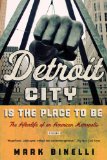Summary | Excerpt | Reviews | Beyond the Book | Readalikes | Genres & Themes | Author Bio

Critics' Opinion:
Readers' Opinion:
First Published:
Nov 2012, 336 pages
Paperback:
Nov 2013, 336 pages
 Book Reviewed by:
Book Reviewed by:
Poornima Apte
Buy This Book
Would my kids one day grow up thinking the same thoughts about America as a whole, about my ponderous tales of cold war victories and dot-com booms? It was easy to let your imagination drift in melodramatic courses. A malaise spreading through the rest of the country—a creeping sense of dread that, after spending the past eight years doing absolutely everything wrong, this time we really had reached the inevitable end of our particular empire—all of this had the effect of making Detroit, for the first time in my life, feel less like a crazy anomaly and more like a leading indicator. The mood of hopelessness had become palpable. I found myself fleetingly wondering if Detroit, in the end, might reclaim its old title after all—not the Motor City but the city of tomorrow.
John said we should go. I squinted out over the ledge one last time. The icy wind was almost harsh enough to make you cry, and Detroit, from up here, looked like it went on forever.
The story of Detroit has long functioned as a cautionary tale, as much a memento mori as one of those Roman catacombs lined with the skulls of dead monks. What you are now, we once were; what we are now, you will become. For this reason, observers have a tendency to approach Detroit as a forensic investigation, a sort of murder mystery. They examine the body, poke their gloved digits into the wounds, dust the crime scene for prints. Whom you ended up fingering in the drawing room could often say as much about your own biases as about the city itself. For instance, when people place all of the blame for the demise of Detroit on the riots, or white flight, or "political corruption," there's an implicit racial—sometimes racist—element to the critique, as Detroit, post-1967, would become a black city, still 85 percent African American today, run entirely by a black political elite, which lends the nostalgia for the "old" Detroit expressed by so many white suburbanites of a certain age an occasionally disquieting subtext.
Unsurprisingly, black Detroiters of a similar age can offer up a wholly different reading of these events, one in which the word uprising replaces riot, and in which the destructive fallout, while not celebrated, is contextually understood as a reaction to years of workplace discrimination, redlining, slum housing, and abuse at the hands of goon-squad cops. As for the city's subsequent decline, well, an observer sympathetic to this point of view might note that of course the oppressors would not simply flee, not without sacking the joint on the way out the door and doing everything possible once they'd gone (top-down disinvestment, supporting lopsided suburb-favoring land use and tax structures, dismantling public transportation, more redlining) to ensure the failure of, and effectively place sanctions upon, the hostile regime left behind.
Some blame the unions for their unchecked power and excessive demands, making Michigan an impossible place to do business; others, the Big Three automakers, for selling out the working class by moving factories abroad and to southern "right to work" states and for so badly bungling their own business model with chronic shortsightedness and an inability to adapt to a world involving actual competition with high-quality foreign product. Environmentalists might see the combustion engine as Culprit Zero; urbanophiles, the metastasizing suburbs; leftist European academics, the rot of capitalism and the long-fated unraveling of our great Yankee folly.
But I wasn't really interested in any of that. Detroit-as-whodunit had been done, ad nauseam. Rather than relitigate the sins of the past, I hoped to discover something new about the city—specifically, what happens to a once-great place after it has been used up and discarded? Who sticks around and tries to make things work again? And what sorts of newcomers are drawn to the place for similar reasons? These questions seemed particularly pertinent now that Detroit was no longer such a freakish outlier. Cities in Florida and California, in the Rust Belt and the Sun Belt, in England and the Mediterranean and who knew where next, they'd all woken up to the same problems that have been pummeling Detroit for decades, including but not limited to structural bankruptcy, unsustainable city services and public obligations, chronic unemployment, vacant and increasingly worthless real estate, and the disappearance of a workable tax base. Left unchecked, Detroit levels of crime, political instability, and blight would certainly follow.
Excerpted from Detroit City Is the Place to Be by Mark Binelli. Copyright © 2012 by Mark Binelli. Excerpted by permission of Metropolitan Books. All rights reserved. No part of this excerpt may be reproduced or reprinted without permission in writing from the publisher.





The Funeral Cryer by Wenyan Lu
Debut novelist Wenyan Lu brings us this witty yet profound story about one woman's midlife reawakening in contemporary rural China.
Your guide toexceptional books
BookBrowse seeks out and recommends the best in contemporary fiction and nonfiction—books that not only engage and entertain but also deepen our understanding of ourselves and the world around us.